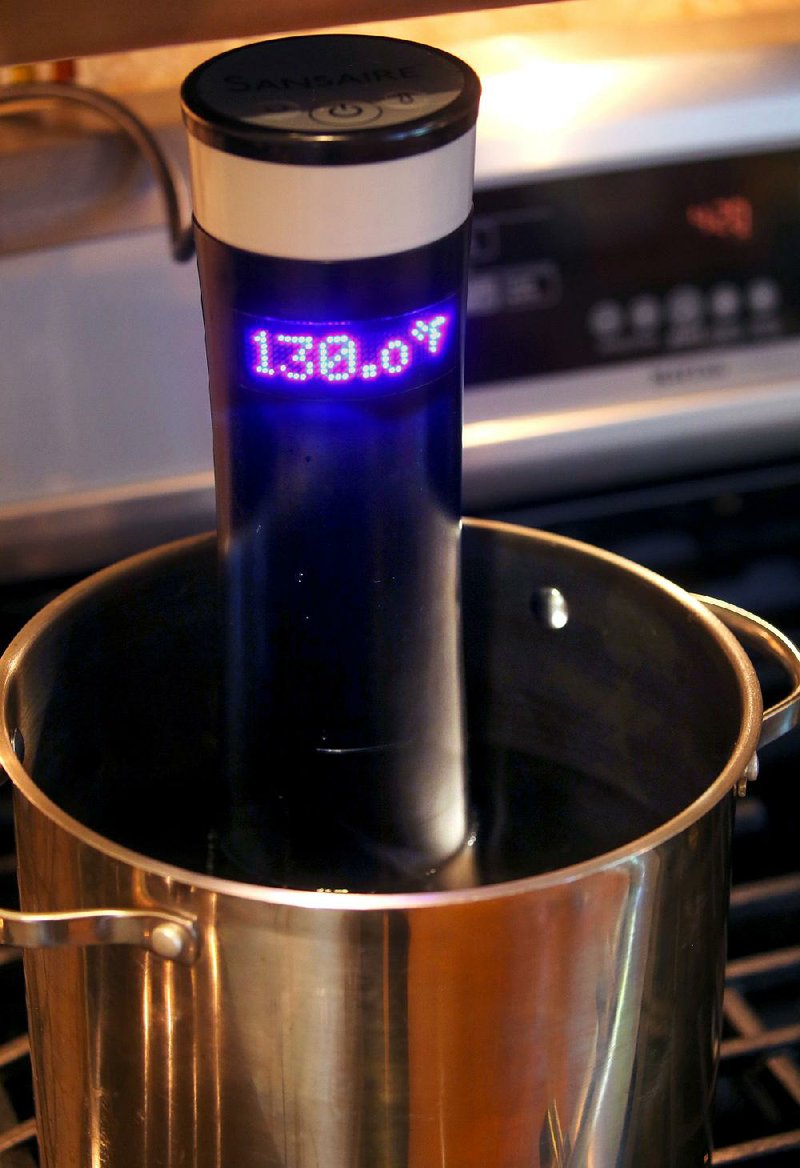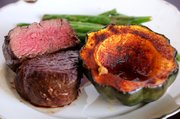Sous vide, French for "under vacuum," is the latest fad to hit the culinary world. This gentle cooking method promises to produce the most tender meats with no change in flavor or attrition of the food.
The process is simple. The food is placed in a plastic bag with as much air removed as possible -- that's the vacuum part -- sealed and submerged in a circulating water bath at a precise temperature for a specific length of time. This is not the boil-in-a-bag effort from the 1970s. Sous vide (pronounced soo-veed) cooking is more sophisticated and is practically error-free.
You will need two things to cook this way.
First, you have to acquire an immersion circulator. J. Kenji Lopez-Alt, chief culinary adviser of the website Serious Eats explains, "An immersion circulator is a device that you insert into a tub or pot of water. It draws water from the tub, heats it up to a precise temperature, then spits it back out, simultaneously heating and circulating the water. A good one will have single-degree precision and accuracy." Immersion circulators cost between $75 and $300.
Next, you need a tub or container such as a deep soup pot for the water bath. There are sous vide cooking vessels, but they are pricey and a good plastic bin can do the trick.
The immersion circulator does all of the heavy lifting. But be forewarned: This is not a speedy process. The goal is to have the food reach its ideal temperature evenly and slowly. That's what most chefs agree is the key to perfect meats: the temperature. Because the food is cooked at its ideal temperature, it won't overcook, which is always a risk with high-heat methods such as baking or grilling. And because the food is sealed in a plastic bag, it won't dry out.
You do not have to buy a vacuum sealer to be the next great sous vide chef. Home chefs often do not use them. Yet, restaurants do, in order to comply with local health department food-safety requirements. The Capital Hotel's executive sous chef Marc Guizol says, "What is amazing is that the bag gives concentrated flavors and provides excellent marinating." He prefers a vacuum sealer to avoid any bacteria, and cautions, "Make sure you completely seal the bag" if you aren't using the vacuum sealer.
How did a country of convection-oven loving and outside-grilling cooks get so excited about food in a water bath with circulating heat? We have Thomas Keller, famed mastermind behind restaurants French Laundry and Per Se in New York, to thank. He studied the craft and started using it in the early 2000s at his restaurants. He says in his book Under Pressure, "even a 2-3 degrees difference" can make a big difference in the outcome of an entree.
Chefs at high end restaurants in Little Rock employing the sous vide method, in addition to the Capital Hotel's, include those at Petit & Keet and Cache.
The University of Arkansas-Pulaski Technical College Culinary Arts and Hospitality Management Institute includes the technique in its curriculum. Institute Dean Todd Gold, says students "cook proteins mostly [with sous vide.] Because it is a slow cooking process (below 140 degrees) for a long period of time with the water circulating, that helps break down the proteins. So, proteins like short ribs that hardly ever get all the way tender can be done so, to the point where you can cut it with a fork."
For the home cook, one obvious difference in cooking sous vide is the time commitment. This is not fast food. A medium-rare beef filet sous vide cooks at 130 degrees for one hour in the water bath, followed by a high heat sear. Yet, it is the final step -- the high heat sear -- that is the most important for taste and texture. When the food is removed from the plastic bag, it will be unsightly. But then the magic occurs. Very high heat in an iron skillet caramelizes and finishes the meat to perfection. Some prefer a grill at this point, or even a blow torch. Use any method you prefer, just find something to sear the meat.
You have several options for bagging and sealing the food.
The most efficient, but also the most expensive, is to use a vacuum sealer such as Foodsaver, and specially designed bags.
All of the following recipes were done without one. We used Ziplock brand freezer bags and manually removed the air.
The most low-tech way is to use a drinking straw to suck as much air from the bag as possible, then quickly seal the bag. This method is not recommended for raw meats or poultry.
A third option is what Anova, an immersion circulator manufacturer, calls the "water immersion" method. Place the food in a zip-close bag and slowly lower the bagged food into a bowl of water, letting the pressure of the water press air through the top of the bag. Once most of the air is out of the bag, carefully seal it just above the water line.
One final challenge for foods that are not weighty inside the plastic bag is keeping them from floating. That is when some human ingenuity comes in handy. Stainless-steel butter knives or spoons put into the freezer bag, marbles in a bag, or pennies in a bag will work as weights.
One thing you will appreciate when using sous vide is that clean up is a snap. No scrubbing pots and pans. The only clean up is after you sear the meat in a skillet, if you choose to do that indoors. You might miss the smell of roast simmering in a liquid on your stovetop or foods roasting in an oven. On the upside, because with sous vide there is no smell, your house won't reek of salmon or other odoriferous foods. You might even forget it is cooking until you see it on the counter. Yet the final touch of the high heat sear will remind everyone that dinner is served.
Do you have 24 to 36 hours where you want to stare at food in a plastic bag in a bin with a water circulator? Then sous vide cooking of brisket is for you. Brisket is traditionally a tough meat, but not so after slowly cooking at least 24 hours at 140 degrees. After searing, the brisket will slice as would a roast beef and be tender and flavorful.
Bourbon Pork Loin Sous Vide
6 pounds pork loin
1 teaspoon onion powder
1 teaspoon ground black pepper
1 teaspoon garlic powder
1 teaspoon smoked paprika
1 teaspoon salt
1/2 teaspoon chipotle powder
1/2 teaspoon cinnamon powder
1/2 teaspoon cumin powder
6 tablespoons brown sugar, divided use
1 stick butter, melted
1 cup bourbon
Vegetable oil, for searing
Prepare the water bath and set the immersion circulator temperature to 140 degrees.
Using a sharp knife, score fat of pork loin in a diamond pattern.
In a small bowl, combine the onion powder, black pepper, garlic powder, paprika, salt, chipotle powder, cinnamon, cumin and 1 tablespoon of the brown sugar. Coat pork loin in rub mixture.
Place meat in a sealable plastic bag (Ziplock brand recommended), remove as much air as possible and seal bag. Or, use a vacuum sealer to bag and seal food according to manufacturer's directions.
Cook 10 hours. Remove meat from bag, drain well and thoroughly dry with paper towels.
Combine remaining brown sugar, butter and bourbon to make a glaze.
Lightly coat an iron skillet or grill grate with vegetable oil. Heat on high. Sear the dried pork loin on all sides. Brush with glaze and continue cooking, turning on all sides, until glaze is caramelized.
Makes 12 generous servings with leftovers.
Recipe adapted from Sous Vide Everything on YouTube
Sous Vide Whiskey-Poached Peaches
2 peaches, pitted and quartered (see note)
1/2 cup rye whiskey
1/2 cup sugar
1 teaspoon vanilla extract
Pinch kosher salt
Ice cream or whipped cream, for serving
Prepare the water bath and set the immersion circulator temperature to 180 degrees.
Combine all ingredients in a large sealable plastic bag (Ziplock brand recommended). Seal the bag, removing as much air as possible, and place in water bath. Set the timer for 30 minutes.
After 30 minutes, empty bag contents into a saucepan, bring to a boil then reduce heat and simmer 15 to 20 minutes. Serve with whipped cream or ice cream. Or both.
Makes 4 servings.
Note: Fresh peaches are preferred, but thawed frozen peaches will work too.
Recipe adapted from anovaculinary.com
Sous Vide Glazed Carrots
1 pound medium to large carrots, peeled and cut into 1-inch chunks
2 tablespoons unsalted butter
1 tablespoon granulated sugar
Kosher salt
Ground black pepper
Chopped fresh parsley, optional
Prepare the water bath and set the immersion circulator temperature at 183 degrees.
Place carrots, butter, sugar and 1/2 teaspoon kosher salt in a sealable plastic bag (Ziplock brand recommended). Seal bag, removing as much air as possible, and place in water bath. Cook carrots in the water bath until fully tender, about 1 hour. At this point the carrots can be stored in the refrigerator for up to 1 week.
Empty contents of bag into a 12-inch, heavy-bottomed skillet and cook over high heat, stirring constantly, until liquid has reduced to a shiny glaze, about 2 minutes. Season to taste with salt and pepper, stir in parsley (if using) and serve. If glaze breaks and turns greasy, add water a teaspoon at a time, shaking pan to re-form glaze.
Makes 4 servings.
Recipe adapted from one by J. Kenji Lopez-Alt, via SeriousEats.com
Food on 10/04/2017

